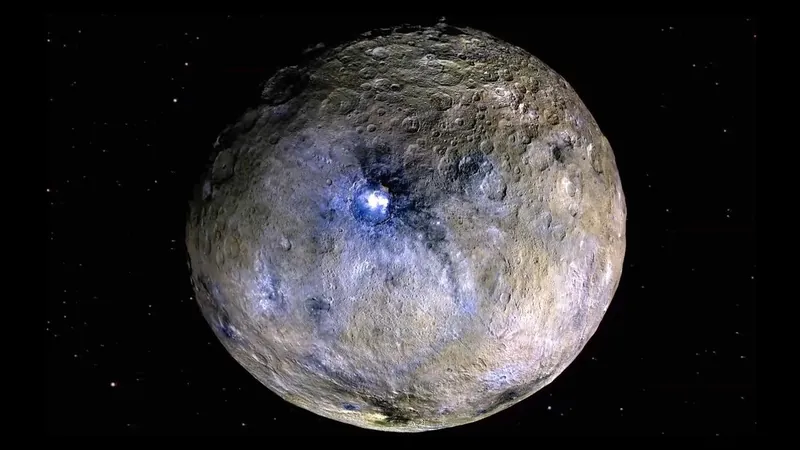
Dwarf Planet Ceres: Evidence of a Muddy Ocean Unveils Secrets of Our Solar System!
2024-10-07
Author: Yu
Groundbreaking Findings on Ceres
Researchers have unveiled groundbreaking findings suggesting that the dwarf planet Ceres, the largest object in the asteroid belt between Mars and Jupiter, once harbored a muddy ocean beneath its icy exterior. This revelation comes from new computer models indicating that Ceres' outer crust is likely composed of a mix of ice and rocky material, fundamentally altering our understanding of this celestial body.
Ceres: Characteristics and New Insights
With a diameter of 588 miles (946 kilometers), Ceres exhibits several intriguing characteristics that hint at its icy nature. Ian Pamerleau, a Ph.D. student at Purdue University, noted that surface features like pits, domes, and landslides suggest a significant presence of ice just beneath the surface layer of dusty regolith. Spectroscopic data further supports this theory, revealing ice hidden below Ceres' surface, while gravitational measurements indicate a density consistent with muddy ice.
Challenging Previous Assumptions
Despite earlier skepticism among planetary scientists—especially after NASA’s Dawn spacecraft conducted a close examination of Ceres from 2015 to 2018—the latest computer simulations challenge previous assumptions. Ceres' rough terrain is marked by an abundance of stark craters with steep walls, which on other icy celestial bodies tend to soften or disappear over time due to the flow of ice. This led many to conclude that Ceres could not have an icy crust.
Simulation Studies Lead to New Interpretations
Pamerleau, alongside his Ph.D. supervisor Mike Sori and NASA's Jennifer Scully, ran simulations exploring how craters on Ceres would evolve over billions of years, considering various combinations of ice, dust, and rock in the crust. The results revealed that a crust composed of 90% ice alongside dust and rock would almost resist flowing under Ceres' gravity, allowing these craters to survive for extended periods.
Ceres as an Ocean World
“We interpret this evidence to mean that Ceres was once an ocean world, similar to Europa, but with a muddy ocean,” stated Sori. As this ocean cooled and froze over time, it led to the formation of a frozen crust mixed with rocky particles.
Implications of an Ancient Ocean
Anciently, after Ceres’ formation, when it was still warm, it seems probable that this icy crust sustained a liquid ocean beneath a thin layer of ice. Researchers are eager to uncover how long this potential ocean lasted, as residual heat from radioactive decay could have maintained liquid water long after Ceres' initial thermal energy dissipated.
Unique Opportunities for Study
Unlike other icy moons like Europa or Enceladus, which are challenging to investigate due to their radiation exposure, Ceres represents a prime target for study. “This discovery is exciting because we have a frozen ocean world that is relatively close to Earth,” Sori emphasized. The proximity and relative safety of Ceres offer an unparalleled opportunity for scientific exploration, making it feasible to retrieve samples that could unveil its watery past.
Potential for Further Discoveries
Notably, areas on Ceres where the ocean appears to have breached the surface—evident in bright deposits seen in Occator Crater—suggest there are vital clues waiting to be uncovered.
Conclusion: A New Era for Ceres Exploration
In conclusion, if these findings are accurate, Ceres could be heralded as the most accessible icy world in our solar system, offering a tantalizing glimpse into the history of water beyond our planet and the potential for exploring other habitable worlds in the cosmos.

 Brasil (PT)
Brasil (PT)
 Canada (EN)
Canada (EN)
 Chile (ES)
Chile (ES)
 España (ES)
España (ES)
 France (FR)
France (FR)
 Hong Kong (EN)
Hong Kong (EN)
 Italia (IT)
Italia (IT)
 日本 (JA)
日本 (JA)
 Magyarország (HU)
Magyarország (HU)
 Norge (NO)
Norge (NO)
 Polska (PL)
Polska (PL)
 Schweiz (DE)
Schweiz (DE)
 Singapore (EN)
Singapore (EN)
 Sverige (SV)
Sverige (SV)
 Suomi (FI)
Suomi (FI)
 Türkiye (TR)
Türkiye (TR)